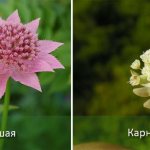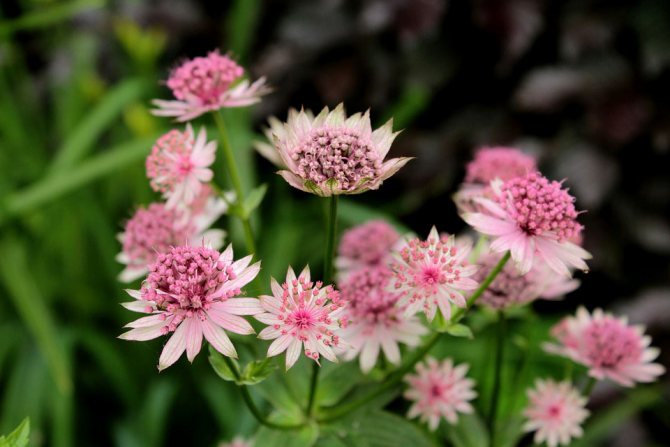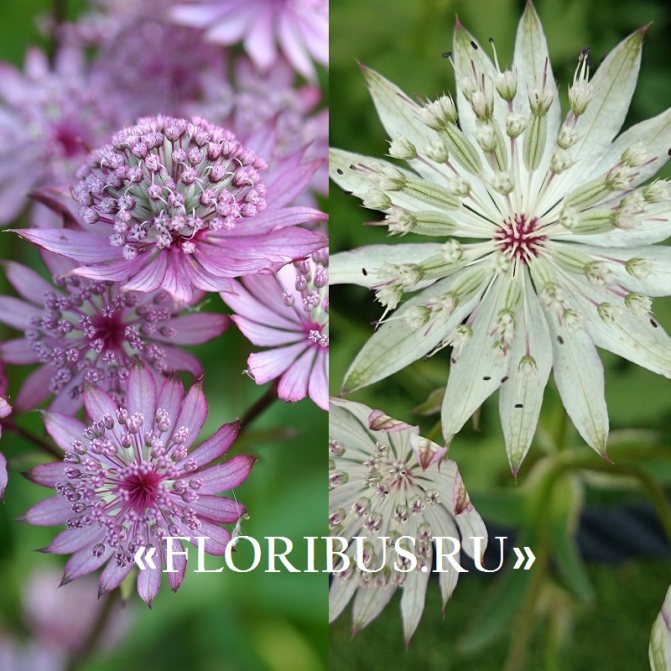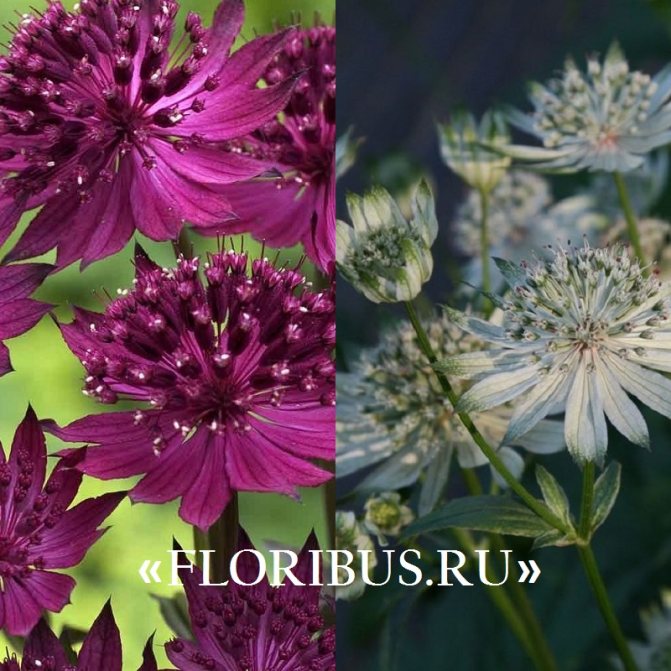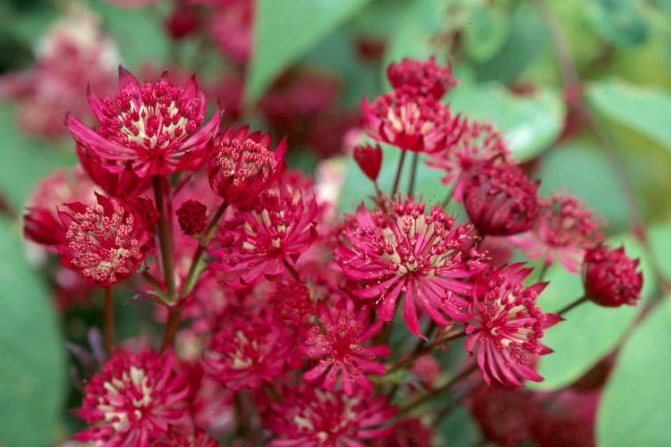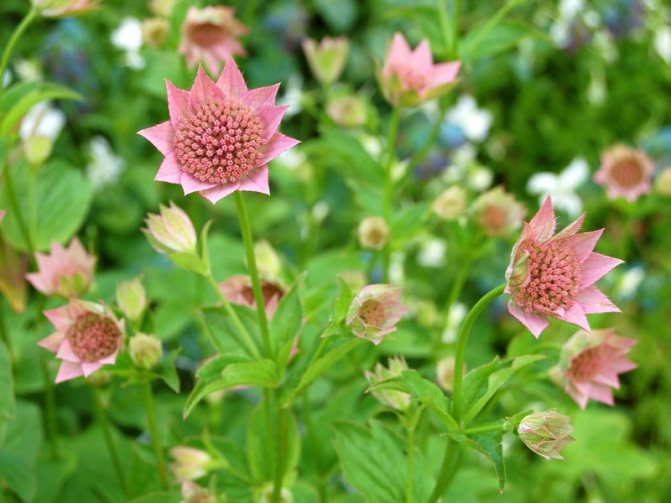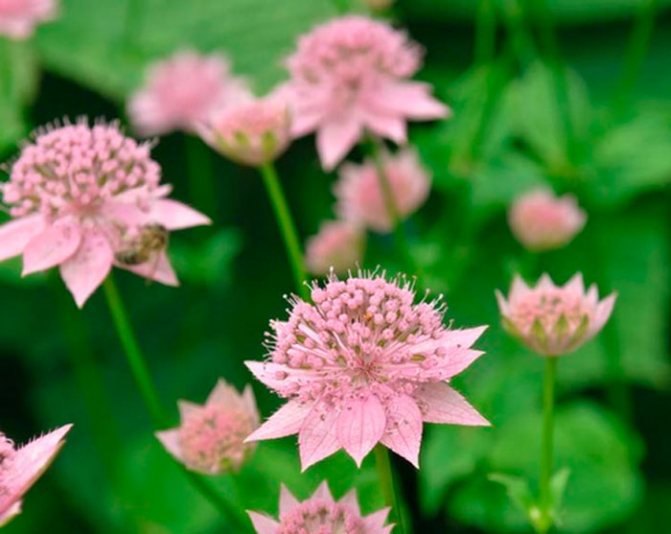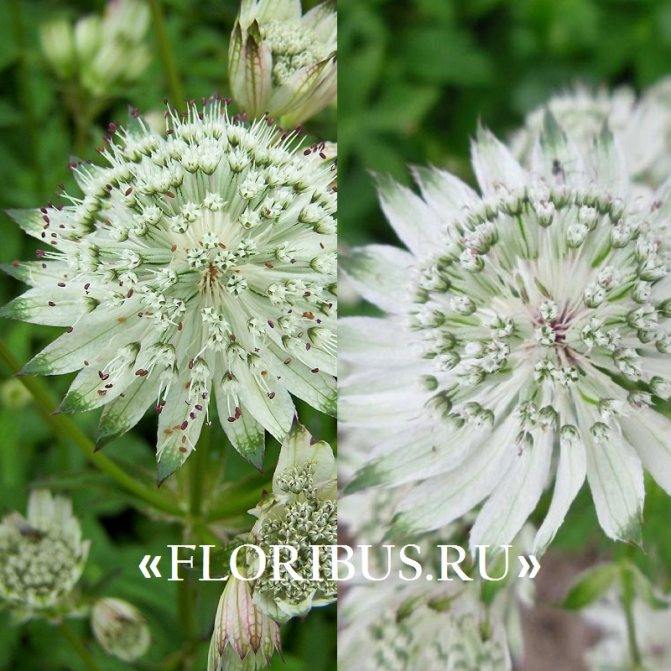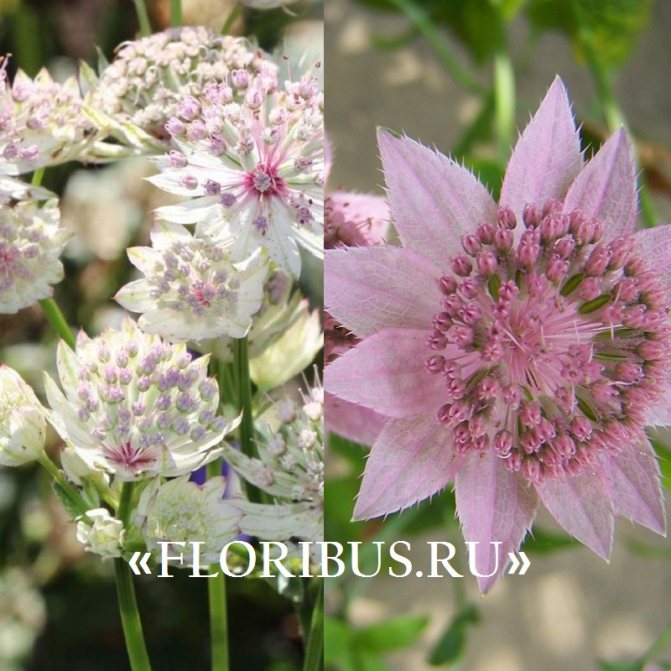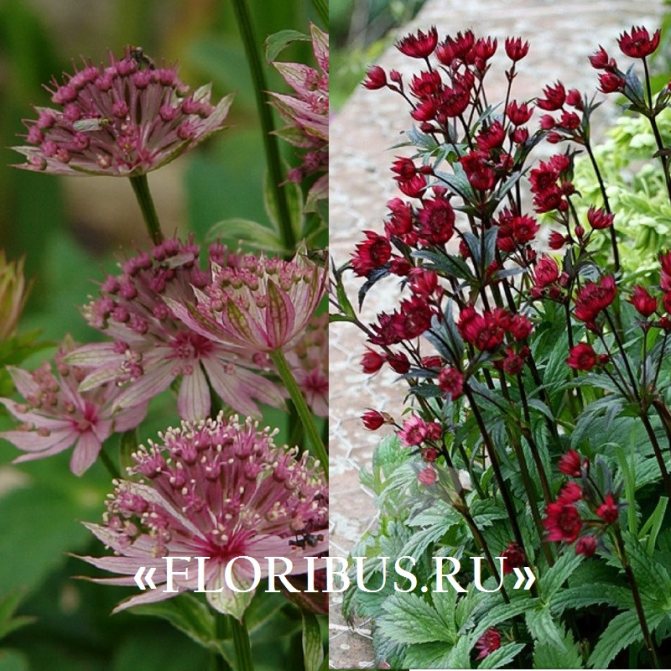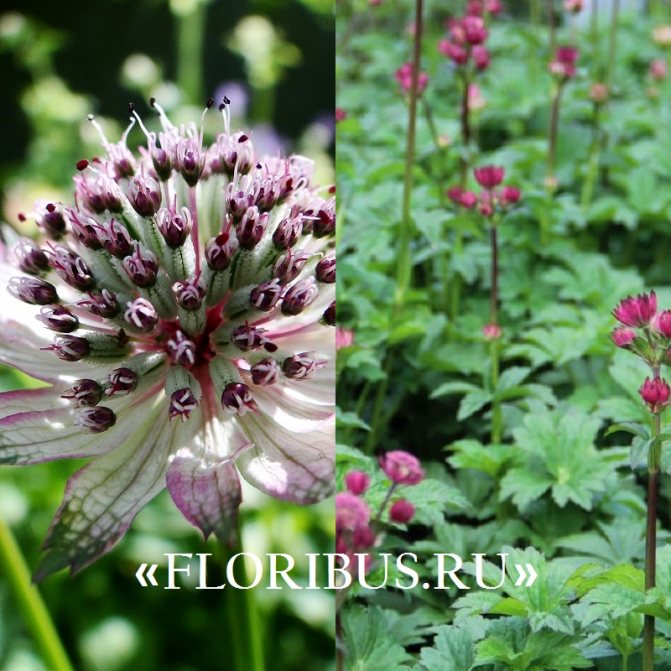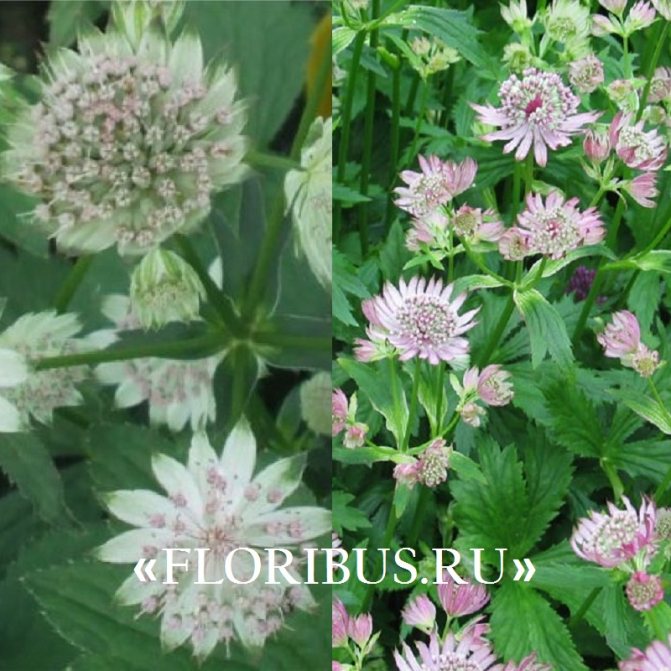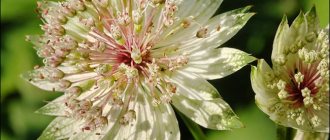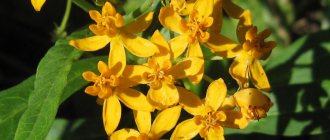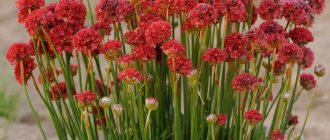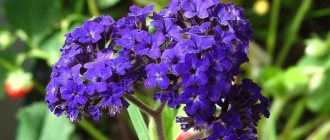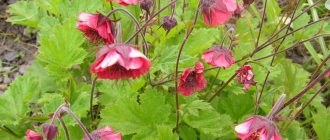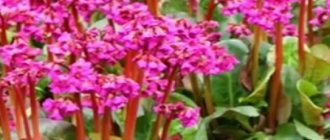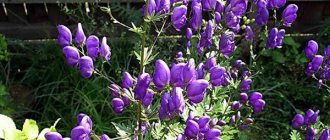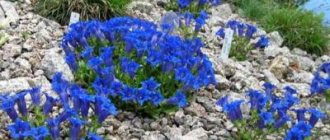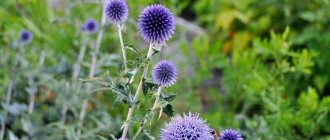The herbaceous plant Astrantia, which is also called asterisk, is a representative of the umbrella family. Such a plant can be found in Eastern, Southern and Central Europe, as well as in the Caucasus. To date, experts have not established exactly where the name Astrantia came from, but there is an opinion that it consists of two words: "astron", meaning "star" (it is assumed that this is due to the shape of the flower), and "antion" - "opposite ”(Most likely, this refers to the covering leaves of the plant). This genus includes about 10 species. In England and America, such a perennial plant is very popular, and it has been cultivated in these countries since the 16th century. At the moment, thanks to the work of breeders, a huge number of garden forms of Astrantia have appeared.
Description of the flower astrantia
Astrantia has unbranched straight stems no more than 1 meter high. Finger-lobed leaves create a single basal rosette. They form small flowers, usually of light shades. The people call the bush an asterisk because of the umbrella-shaped inflorescences that outwardly resemble stars. The wrapper leaves are large, bright green in color. The flowering period occurs in May and lasts until autumn. This time is enough for the development of the fetus - the two-seed.

Astrantia belongs to honey plants, therefore it strongly attracts bees. The plant is able to develop normally in unfavorable conditions, since it has high winter hardiness and resists negative factors.
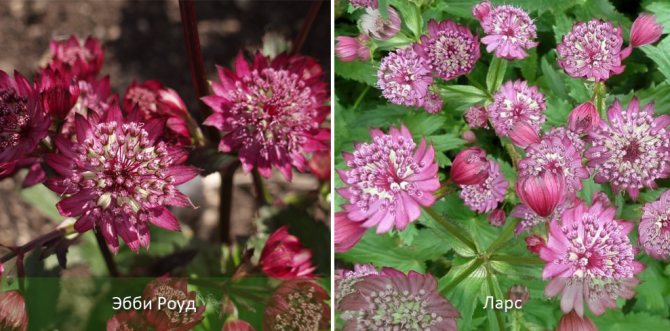
The flower is planted in a few groups. It interacts well with neighboring plants, for example, geraniums, lungwort, geyher, hosts. Astrantia retains freshness for a long time after cutting, therefore it is often used when creating bouquets.
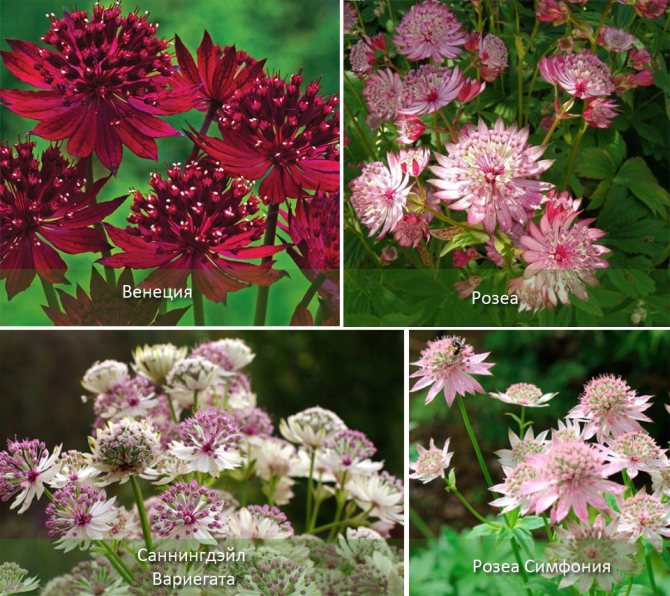

In addition to attractive external qualities, the plant is easy to plant and maintain.
Description and features
Astrantia, or as this culture is also called - asterisk, is a rhizome plant. The height of the bushes ranges from 15 cm to 1 m. Inflorescences come in various shades: from white to rich burgundy and wine, pink. Inflorescences are simple, umbellate in shape. Collected from a large number of small flowers.
A feature of the star is the presence of a wrapper on flowers of a more saturated color. The tips of the wrapper are usually green in color. The flowering period is long. The bushes begin to bloom in early summer. Flowering continues until autumn. Even harsh winters are easily tolerated.
Types and varieties of astrantia
The plant is widespread in Europe and Western Asia. The cultivation of some varieties began as early as the 16th century.
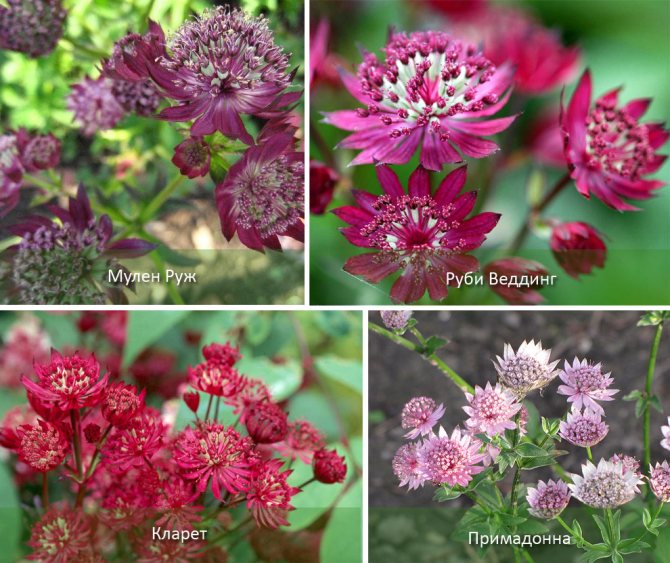

Common types and varieties:
| View | Description | Variety | Description |
| Astrantia Major | It is found on the territory of Ukraine, Moldova, the Baltic countries and Belarus. It chooses forest edges and lawns near coniferous forests as a place of growth. Does not exceed 70 cm. | Moulin rouge | It differs in red inflorescences, the leaves of the wrapper are much darker. If the bush grows in an area with an abundance of sunlight, then the flowers become bright and large. |
| Ruby Wedding | It grows to a height of 65 cm, the flowers are painted in a dark red hue. The best condition for growth will be a darkened area of soil, near trees. | ||
| Claret | Flowers and wrappers are burgundy. Plant height does not exceed 55 cm. It blooms in the middle of summer, and the fruits finish forming towards the end of September. It is better to grow a flower in the shade, it is perfectly cultivated in a container. | ||
| Diva | The highlight of the variety is considered to be dark red flowers with lighter envelopes. The plant is about 70 cm high. The variety thrives both in direct sunlight and in dark places. | ||
| Venice | A feature of this variety is the ruby color of the inflorescences. | ||
| Lars | Reaches a height of about 75 cm, has deep pink inflorescences. | ||
| Sunningdale Variegata | Differs in pale lavender inflorescences. | ||
| Rosea Symphony | It grows up to 70 cm, has pink inflorescences and pale pink wrappers. | ||
| Rosea | Height no more than 60 cm, characterized by spotty leaf plates and bright pink inflorescences. | ||
| Snowstar | White flowers, white wrappers with characteristic greens. Does not exceed 70 cm. It develops best in dark places. | ||
| Abbey road | Red in color, the inflorescences have a purple hue, the wrappers are several shades darker. | ||
| Astrantia Maxima (Largest) | Grows in the Caucasus. It reaches a height of about 70 cm, has a powerful and long root system. The sheets are tripartite. In diameter, simple umbrella-shaped inflorescences are 4.5 cm, include pink flowers. The leaves of the envelope are pale red, their length is about 1 cm, and have a membranous appearance. It blooms in August, but the beginning can be delayed until September. | ||
| Astrantia Carniolica | Perennial plant with finger-split plates. The inflorescences are composed of light colored flowers. The most common variety is rubra. Reaches 70 cm. Flowering occurs in late spring and ends in 3 months. | ||
Some gardeners cultivate Bavarian, three-cut, hellebore species, as well as varieties of large Astrantia - Bieberstein and Alba. Among themselves, they differ in the shade of flowers, height, flowering period and place of territorial localization.


Astransia carniolica
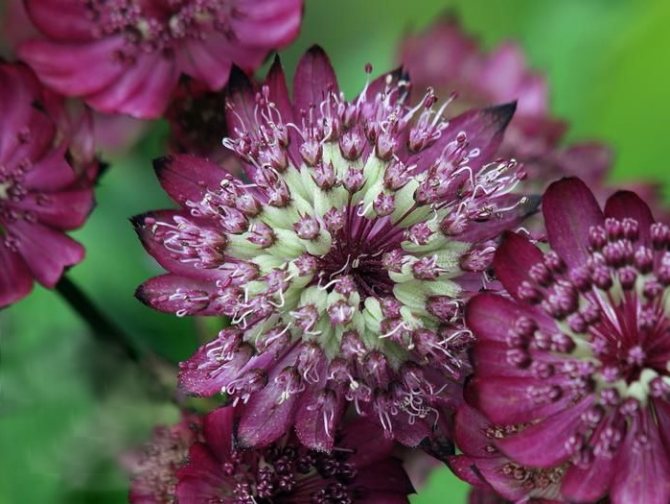

Astrantia Carniolica Astrantia Carniolica 'Rubra'
Perennial herb with palmate-separate opposite leaves, inflorescences in the original white. The most famous variety:
Rubra - bloom from May to August, inflorescences are deep pink with wine-red wrappers, height reaches 70 cm, flowering continues from May to August.
Less common varieties:
- Astrantia Bieberstein;
- three-cut astrantia;
- astrania bavarian;
- Astrantia is hellebore.
Growing Astrantia from seeds
Growing Astrantia from seeds is more difficult than vegetatively, but it is much more economical. The main thing is to consider several important features on which further development and growth rate will depend. First of all, you need to familiarize yourself with the nuances of sowing, and then start growing seedlings.
Sowing seeds of astrantia in the ground
One of the Astrantia breeding methods is self-seeding. It should be borne in mind that such seedlings have incomplete parental characteristics, rather than propagation by cuttings.
Therefore, gardeners recommend using other methods for breeding shrubs. Freshly harvested seeds must be planted closer to winter, so that shoots can already appear in the first months of spring.
Sowing seeds of astrania for seedlings
It is best to plant Astrantia by means of seedlings, in this case the seeds are sown in the spring in special boxes.
For high-quality development, stratification should be ensured - seeds from the autumn harvest are placed in the refrigerator in the vegetable department for 2-3 months. Before that, you must familiarize yourself with the information on the package. If the manufacturer noted that stratification was carried out, then this event can be abandoned.
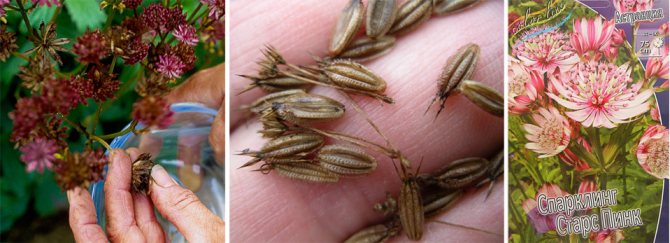

Seeds are sown in prepared soil, it should be light and not contain any special components.
They are distributed over the soil surface, on top of the substrate is laid in a thin layer. The boxes are covered with foil or glass, after which they are placed in a place with moderate humidity and a constant temperature of +22 ° C. When the first seedlings appear, you need to get rid of the shelter.
Astrantia seedling care
With the further development of seedlings, place the boxes in a lighted room. You need to thin out the seedlings in 7-14 days. Small plants are periodically watered when the top layer of the soil dries, the substrate should be loosened regularly. When airing, care must be taken to protect the planting from drafts.
Planting freshly harvested seeds before winter
The soil is dug up and grooves are made in an arbitrary arrangement. Then the seeds are sown. Sprinkle lightly with soil and watered abundantly. For the winter, the seeds can be covered with spruce branches. In the spring, after the snow melts, the shelter is removed. Seedlings should appear in a few weeks. After the bushes grow up, they can be planted or left to grow in one place.
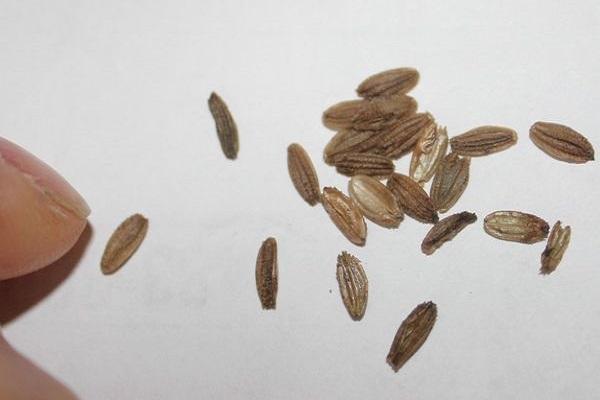

Through seedlings
The second breeding method is seedling. The seeds are first planted at home in boxes, and then transplanted into open ground when they grow up.
Timing
Planting of planting material is carried out in late February - early March. Planting dates largely depend on the region of residence and climatic conditions.
Landing Astrantia in open ground
The health and quality of future plants depends on the quality of planting in open prepared soil. Therefore, this process must be approached as responsibly and carefully as possible.
It is planned to study the peculiarities of the landing of Astrania. Even a novice gardener can cope with the task, since the shrub is not picky about the surrounding conditions and can grow in almost any soil.
When to plant
It is recommended to plant seedlings in late spring or early summer. Having previously familiarized yourself with the features of the variety, since a sunny place is more suitable for some plants, and a dark place for others. The soil should be loose and fertile, but there are no special requirements for the chemical composition.
How to plant
Place the seedlings at a distance of 35 cm from each other. The hole must be made so that the plant is at the same depth as at the stage of growing seedlings. Around the bushes, you need to compact the soil and water abundantly. After 3 years, the first flowers can be seen in Astrantia.
How to plant Astrantia seedlings


Growing Astrantia from seeds
Astrantia can reproduce by self-seeding, while there is a possibility of loss of varietal traits, as the people say: transfer. Therefore, it is desirable to control this process. Note that the seeds of varietal plants will not necessarily retain all varietal characteristics, but they will also be interesting. You can sow a starfish before winter, and thin out the seedlings in the spring. True, in this case, we are not insured against any whims of nature, in case of late frosts we can be left without flowers.


Astrantia from seed When to sow Astrantia for seedlings
This means that it is better to grow seedlings, especially since no special knowledge or skills are needed.
- The seeds need to be stratified (for the winter, put the seeds of astrantia in the vegetable box of the refrigerator), and in March, sow them in light soil, shallow.
- Water, maintain the temperature at about 22˚C, keep under a transparent cover until the first shoots appear.
- Then put in a very lighted place, moisten the substrate, after the appearance of a couple of leaves, the seedlings must be thinned out.
- After a couple of weeks, we dive the seedlings in separate pots, make sure that there are no stable drafts, two weeks before planting in the ground, we begin to harden.
- As soon as we can leave the seedlings at the hardening site for a day, they are ready for planting.
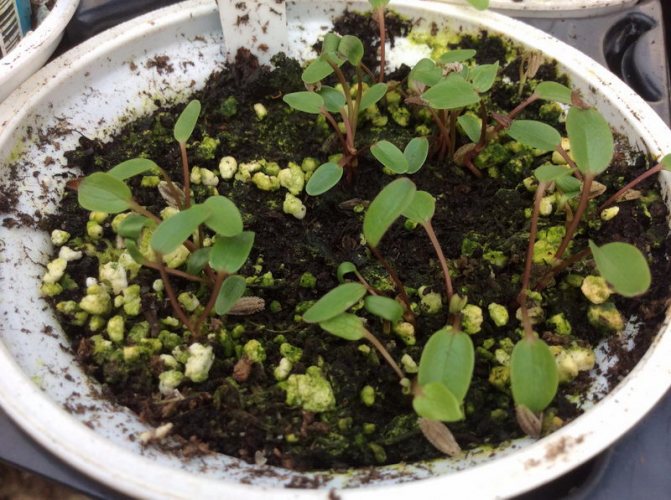

Growing Astrantia for seedlings
You can plant seedlings in open ground in early June.... The ideal place is partial shade, but Astrantia feels great both in open areas and in the shade. The soil is preferably loose, the place is not swampy. For very clayey soils: add a couple of buckets of humus and a bucket of sand to the plot with astrantia, for very sandy soils - only humus. In addition, there are no special preferences for the composition of the soil.
We make holes at a distance of 30-40 cm from each other, we deepen so that the plant is at the same level as in the pot. The land around the planted plant must be compacted and watered abundantly. Typically, such a plant begins to bloom in the 3rd year.
Caring for astrania in the garden
With normal rainfall, no special care is required. During dry periods, the plant should be watered once a week, which will allow it to bloom once. If you keep the soil moist throughout the growing season, the shrub will bloom again. Immediately after watering or rain around the plant, loosen the topsoil and remove weeds. To save time, the site should be mulched with peat or humus.
To prolong flowering and reduce the likelihood of self-seeding, wilted inflorescences must be removed. After the first one, cut off all the peduncles, this will be additional stimulation for the formation of arrows, moreover, this measure allows you to create a symmetrical and dense bush.
Read also: Russia state registry cucumbers indeterminate
Top dressing should be carried out in the first months of spring. Enrich poor soil once every three years with phosphorus-potassium fertilizer in July or August. Add substances in liquid form.
Watering and soil care astrania large
If, nevertheless, the summer is too dry, then watering is done 1-2 times a week. Pay attention to the top layer of the soil: if it is too dry, then watering is needed more often. A special feature of Astrantia is that if the soil is kept moist all days of the growing season, it can bloom again.
After watering, you can loosen the soil or mulch. In the form of mulch, humus is suitable.
In autumn, the leaves and stems are cut, the roots are covered with leaves and other covering material. In spring, the plant begins to actively grow, form buds, and blooms starting in June.


Astrantia in the landscape
Due to the unique visual qualities of the plant, designers love to use it. Astrantia is suitable for creating flower beds and decorating shady areas of the garden, for example, near trees and other bushes.
Low-growing varieties are used for rock gardens and decorating pools.
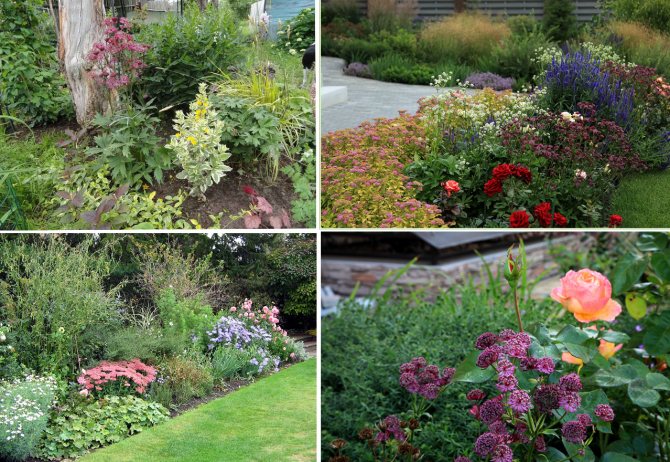

The flowerbed, made up of several types of asterisks, has an original appearance. The modest bushes of the plant lead to the effect of weightlessness and lightness: next to the spreading leaves of Astrantia there are flowers of red, white, pink shades.
Astrantia is a green perennial plant with unusual flowers. It is able to grow in the harshest conditions and is completely unpretentious in care, therefore it becomes the choice of novice gardeners. Roses with large flowers or lilies can be placed as neighbors near the bushes. This combination will create an overall concept that not only looks attractive but smells good as well.


The herbaceous plant Astrantia, which is also called asterisk, is a representative of the umbrella family. Such a plant can be found in Eastern, Southern and Central Europe, as well as in the Caucasus. To date, experts have not established exactly where the name of Astrantia came from, but there is an opinion that it consists of two words: "astron" meaning "star" (it is assumed that this is due to the shape of the flower), and "antion" - "opposite ”(Most likely, this refers to the covering leaves of the plant). This genus includes about 10 species.In England and America, such a perennial plant is very popular, and it has been cultivated in these countries since the 16th century. At the moment, thanks to the work of breeders, a huge number of garden forms of Astrantia have appeared.
The use of astrantia in landscape design
- In landscape design, Astrantia is most often used for flower beds, as well as for decorating the shady corners of the garden: under shrubs and trees.
- Smaller varieties can be successfully used for rock gardens and even near pools.
- A flower bed created from various varieties of a star will look original. The combination of openwork greenery of stars with bright summer flowers is an excellent example of creating a flower bed from flowering plants.
- The modest bushes of Astrantia evoke feelings of airiness, weightlessness: against the background of spreading leaves, the stars of the garden of white, pink, red colors soar. Lilies, small roses with large flowers, will be good neighbors for Astrantia.
Feel free to fantasize and create your masterpieces!
Features of astrania
Astrantia herbaceous plant is rhizome. Its shoots are straight, slightly leafy and slightly branched, their height varies from 0.15 to 0.9 meters. Leaf plates, as a rule, are palmate-separate or palmate-lobed, they have from 3 to 7 serrated lobes along the edge of a lanceolate or obovate shape. They are collected in root rosettes. Simple, umbrella-shaped inflorescences that look like stars, consist of a large number of small ruby-pink or white flowers. The rich green leaves of the wrapper give the plant even more showiness. Flowering begins in May and ends in the first days of autumn. The fruit is a two-seed.
This plant is a honey plant, so it attracts bees to the garden plot. It is also resistant to cold and drought. Astrantia is grown in rabatkas, mixborders, in flower beds, used to create curbs, or planted in groups in the center of the lawn. In the garden, such flowers are recommended to be grown together with lungwort, astilba, hosts, geraniums and variegated heuchera. The inflorescences of this plant are good for cutting because they stay fresh and showy for a long time. Astrantia is also used for drawing up dry bouquets.
This flower is distinguished by its undemanding care and growing conditions. In this regard, it is quite popular among gardeners.
Preparation of planting material
Before planting, the planting material is prepared so that it germinates faster. For this, the seeds are germinated. The planting material is placed in wet gauze and covered on top. The gauze is removed to a warm and dark place. Before sprouts appear, the gauze must be constantly moistened. After 2-3 days, sprouts should appear. After that, the seeds are planted in the ground.
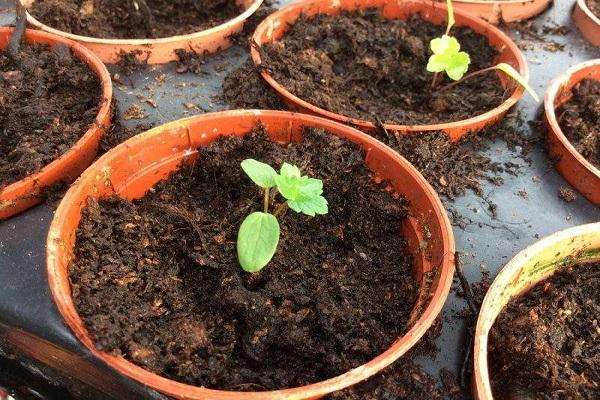

How to plant
Seeds are planted in a loose fertile substrate.
Seed planting process:
- A shallow drainage is poured into the bottom of the container, then eight soil.
- Make shallow grooves in the soil and sow seeds.
- Dig in slightly with soil.
At the end of planting, pour warm water and close the boxes with a plastic bag. Thanks to this measure, seedlings will begin to appear faster.
Temperature and light conditions
Seedling boxes are placed on sunny windows. Seedlings grow better if they are in the sun all day. The room temperature should be at least +18 degrees. Seedlings do not tolerate sudden changes in temperature.
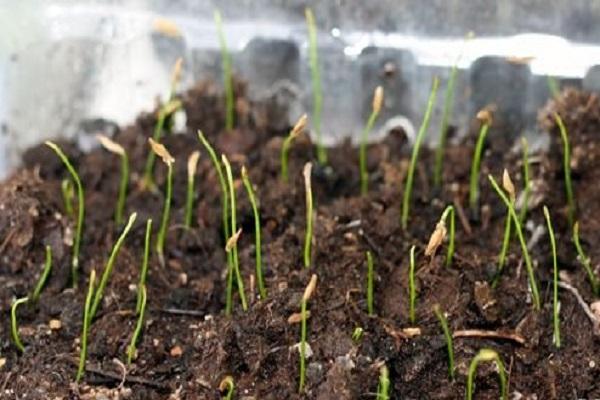

Picking
A pick is carried out after the seedlings have grown up and a couple of full-fledged leaves will appear on each seedling. Bushes are transplanted into peat pots. Then, together with them, they are planted in open ground.
The picking can be skipped if the seedlings do not grow close to each other, and the astrantia has enough space in one container.
Hardening
A few weeks before transplanting into open ground, the seedlings begin to harden. Boxes with seedlings are taken out into the street at first for 15 minutes. Each time, the residence time should increase until it reaches an hour. You can not take seedlings outside if the weather is very cold.
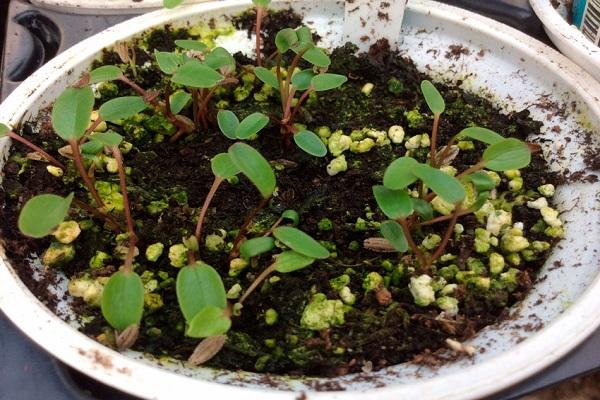

Growing Astrantia from seeds
Sowing
Astrantia is able to reproduce independently by self-seeding. However, it should be taken into account that in such seedlings the varietal characteristics of the parent plants are not completely preserved. In this regard, experienced gardeners recommend choosing other methods for propagating such a flower. Sowing freshly harvested seeds can be done before winter after the shoots appear in spring, they only need to thin out. If desired, Astrantia can be grown through seedlings; for this, the seeds are sown in early spring in boxes. However, in this case, they will need stratification; for this, the seeds of the autumn harvest will need to be placed in the refrigerator in a vegetable drawer for 8-12 weeks. By the way, carefully inspect the packaging purchased from the Astranian seed store, if it does not indicate that they were stratified by the manufacturer, then you will have to do it yourself.
For sowing seeds, use nutritious light soil. They are distributed over its surface, and sprinkled on top with a thin layer of substrate. The boxes should be covered with glass or foil and put away in a warm place (from 20 to 23 degrees). When the seedlings appear, the shelter must be removed.
Growing seedlings
After the first shoots appear, the boxes should be rearranged in a well-lit place. When 1-2 weeks pass after the seedlings appear, they will need to be thinned out. The plant must be systematically watered after the top layer of the soil dries up, and the substrate must also be carefully loosened. When ventilating the room, make sure that the seedlings are protected from drafts.
Picking
When the plants have the first pair of true leaf plates, they need to be cut into individual pots, using the same soil mixture as for sowing. You need to start hardening the plants 1.5 weeks before planting. To do this, the seedlings are daily transferred to the garden or to the balcony, while the duration of its stay in the fresh air should be increased gradually. Planting seedlings in open soil can only be done after it has fully adapted to new conditions.
How to plant astrania
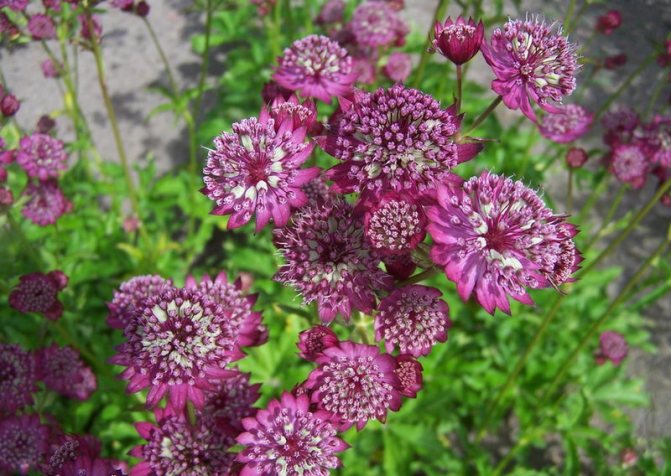

Flowers Astrantia Carniola Rubra planting and care
The negative experience of some gardeners shows that seeds do not always germinate, even with proper stratification (it must also be done for purchased seeds, if the package does not indicate that the seeds are already stratified), and varietal characteristics are lost, therefore, a more correct way is division of the rhizome.
You can divide the Astrantia bush in the spring ...
before the start of the growing season, or in the fall, when the growing season comes to an end.
- We dig out a bush and carefully divide it into several parts. We plant each part separately, at a distance of 40-50 cm from each other, having previously seasoned the hole with rotted manure.
- The next season (or this one, if the division is in spring), young shoots will appear and the new plant will bloom in the third year. Only in this way can rare varieties be propagated.
Peat rhizomes can also be bought at a flower shop. And it doesn't matter if you come across such planting material in the middle of winter. Feel free to buy and start growing Astrantia at home.
We take an ordinary substrate for growing indoor plants, pots for seedlings or plastic cups of a suitable size, plant delenki of Astrantia, put them on a warm windowsill, water and wait for the sprouts. For better aeration of the soil, the earthen substrate can be supplemented with vermiculite, and for moisture control with a hydrogel.
The flower quickly releases the first leaves, even from the smallest pieces of rhizome
therefore, do not be alarmed if you come across small planting material.
As it warms, move the astrantia to the loggia or balcony along with the rest of the seedlings. If the glass with a young plant is transparent, then you will see how the root system develops, entwining an earthen ball. Astrantia does not like waterlogging, which means it needs to be watered when the soil in the cups is practically dry. Otherwise, there will be no hassle with this plant.
Just like the seedlings, we transfer the hardened stars into open ground at the beginning of June. Also, cuttings of rhizomes can be planted immediately in open ground, after having fertilized it well, do not forget about watering, and in 3-4 weeks you will get a young bush. Not a lot of trouble.
Landing Astrantia in open ground
What time to plant
As a rule, planting seedlings of Astrantia in open soil is recommended in the last days of May or the first days of June. For planting, both a well-lit area and one located in a small shade of trees are suitable. The soil must be necessarily nutritious and loose, and its composition can be almost any.
How to land correctly
There is absolutely nothing complicated in planting and caring for such flowers. When planting between the bushes, a distance of 0.3 to 0.4 m should be observed. It should be noted that after planting the plant should be at the same level as it grew in the pot. Around the planted plants, the soil should be tamped, and then they are watered very well. The flowering of Astrantia grown through seedlings begins after 3 years.
Diseases and pests of astrania big
Zvezdovka is a very hardy plant, practically not damaged by pests and rarely gets sick. Sometimes the bushes are attacked by naked slugs, which devour the leaves. Astrantia, eaten by slugs, loses its attractiveness and decorativeness.
If these pests are found on flowers, they must be manually collected and destroyed. It is possible to use the preparation "Thunder" to protect Astrantia from naked slugs.
Sometimes the plant suffers from waterlogging, especially on heavy acidic soils. Treatment is reduced to orderly watering and timely loosening of the soil around the flower.


One of the most unassuming, but at the same time amazing plants in our garden is a large astrania. Planting and caring for it is simple and not time consuming. Moreover, Astrantia does not even need to be transplanted too often.
Bright and long flowering, spectacular appearance, low prevalence and exclusivity will allow you to create stunning corners of greenery and picturesque colors on the site.
Caring for astrania in the garden
Astrantia is one of the most undemanding garden plants to care for. If in the summer there is no abnormal heat and prolonged droughts, then such a plant can not be taken care of at all, since it is distinguished by its hardiness and resistance to drought. If the summer turned out to be sultry and dry, then in this case, Astrania will not need a lot of watering. In the event that you expect only one flowering from it, then during the most severe drought it will need to be watered only once every 7 days. However, if you want such a plant to bloom again, you will need to choose such a watering regime so that the soil near the bushes is a little moist all the time throughout the growing season. After the flowers have been watered or the rain has passed, do not forget to loosen the surface of the site and at the same time pull out all the weeds. To significantly reduce the number of watering and weeding, it is recommended to cover the surface of the site with a layer of mulch (peat or humus). In order for Astrantia to bloom longer and not reproduce on its own, it is necessary to cut off the inflorescences that have begun to fade in time.When the bushes bloom for the first time, it will be necessary to cut off all the inflorescences, this will stimulate the growth of new flower arrows, and the bush will also become more lush and symmetrical.
Read also: Cabbage variety Amager characteristics
In the event that Astrantia is grown in nutritious soil, then it will need to be fed only 1 time per season at the beginning of the spring, and a complex mineral fertilizer is used for this. If it has been growing on poor soil for more than three years, then it is recommended to feed it 1 more time in the second half of the summer period, in which case potassium-phosphorus fertilizer is used. It is recommended to feed it with liquid fertilizer, but if you apply it to the soil in a dry form, then be sure to water the flowers after that.
Astrantia can be grown in the same place for no longer than 10 years. However, experienced gardeners advise planting bushes every 5-7 years. In some cases, such a plant may need a garter to a support, especially during the rainy season.
Reproduction of Astrantia
Astrantia can be propagated in the same way as almost all other perennial herbaceous plants grown in the garden, namely by dividing the bush and seeds. How to propagate it through seedlings is described in detail above. However, store-bought seeds are stratified by experienced gardeners for 8 weeks and then sown directly into open soil in the spring after the ground has warmed up enough. If the seeds have just been harvested, then they are sown before winter immediately in the open ground.
But when propagating Astrantia by seeds, it should be taken into account that the seedlings may not retain the varietal characteristics of the mother plant. In this regard, it is recommended to propagate this plant by dividing the bush, which is carried out in the spring (before the leaves appear) or in the fall (at the end of the growing season). To do this, divide the root nest into several parts, which must be planted, and do not forget to keep a distance of 0.4 to 0.5 m between the bushes, while humus must be added to each hole. After 4 weeks, the delenki will start to grow and they will have sprouts, and after 12 months they will not differ much from adult plants. Plants propagated by dividing the bush will begin to bloom after 3 years. This method is most often used in order to propagate very valuable or rare varieties.
Diseases and pests
Such a plant has a very high resistance to diseases and pests. But if it is wrong to follow him, then this can significantly weaken his immunity. For example, if Astrantia is constantly watered very abundantly, this can cause the development of a fungal disease. To cure the affected bushes, they should be treated with fungicides, for example, Quadris, Fitosporin, Fundazol, Bravo, or other means of a similar action.
Reproduction of astrantia large by dividing the bush
This method of breeding Astrantia is carried out either in early spring, when the first leaves have not yet appeared, or in the fall, when the starlet has already faded. You need to dig out the bush in half, that is, remove the earth on one side only.
Then divide the rhizome into the required number of parts (preferably no more than three). Next, one part must be left in a half-dug hole, and the other parts must be carefully separated with an earthen lump and transplanted into pre-prepared holes.
Do not forget to add humus or other fertilizer to the transplant pit, as well as water after instillation.


Astrantia after flowering
Seed collection
If you are planning to collect seeds from Astrantia, then during flowering, outline the most spectacular and large inflorescences. When they begin to dry out, they should be covered with gauze bags, which will prevent the ripe seeds from spilling out onto the surface of the site.Completely dried seeds must be cut and placed for final drying in a well-ventilated dry room, spreading them out on a newspaper sheet. After they are completely dry, you will need to extract seeds from them, from which dried petals are removed. The seeds are placed in a small cardboard box or in a paper bag, which is removed in a dark and dry place.
How to prepare for wintering
Preparing Astrantia for wintering should be done in autumn. To do this, you need to cut off its stems almost to the level of the surface of the site. Then the bushes are mulched with peat or humus. For sheltering young bushes, it is recommended to use spruce branches. If Astrantia is already an adult, then it is quite capable of surviving the winter without shelter.
Care features


In order for the bushes of Astrantia to be lush, blooming for a long time and not lose their decorative qualities over the years, it is worth using the following recommendations:
- During the entire period of active flowering, wilted inflorescences should be cut off. Thanks to this, new flowers will form, which are most often more luxurious and voluminous than the first.
- The plant needs a single feeding only during the growth period, in the spring. The rest of the time it is not worth adding fertilizer to the soil - in this case, all the power will go to the development of the bush, and it will bloom poorly.
- The starlet's only enemy is slugs. To protect the plant from them, you can use ash or purchase special products.
- When Astrantia fades, the stems of the plant are mown - this is the only way to avoid self-seeding and the spread of the flower throughout the garden. To prepare seeds, the stems of plants with umbrellas are hung in a dark, dry place and a container or newspaper is placed under them, on which the ripe seeds will fall.
Types and varieties of astrantia with photos and names
In total, there are more than 10 different types of Astrantia, but only 3 of them are cultivated most.
Astrantia major, or large astrantia
In nature, this species can be found in the west of the European part of Russia, in Moldova, Ukraine, Belarus, Central Europe and in the Baltic countries. Such a plant prefers to grow on lawns and edges of deciduous and coniferous forests. The height of the spreading bush is about 0.7 m, and its diameter is about 0.4 m. The root rosette consists of three to seven-part long-petiolate leaf plates. Light pink flowers are collected in simple umbrella-shaped inflorescences, the diameter of which is about 50 mm. The color of the leaves of the wrapper is green or light pink. It has been cultivated since 1597. The most popular varieties:
- Moulin rouge... The inflorescences are colored wine-red, while the leaves of the wrapper are of a darker, almost black shade. The flowers of bushes grown in sunny areas are most effective.
- Ruby Wedding... The bush reaches a height of 0.65 m, the color of the flowers is dark red. This variety is recommended to be grown in a shaded area.
- Claret. The color of the flowers is burgundy, transparent wrappers of the same color. Plant height 0.55 m. Astrantia blooms in the first days of July, and flowering ends in the last days of September. Recommended to grow in partial shade and shade. Can be cultured in a container.
- Diva... The flowers are dark red, and the wrappers are colored in a lighter shade. Plant height approximately 0.7 m. The variety can be grown in a sunny or shaded area.
- Venice... The color of the inflorescences is ruby.
- Lars... The height of the bush is about 0.75 m, it is decorated with pink inflorescences, their color is so rich that it seems to glow in the dark.
- Sunningdale Variegata... The color of the inflorescences is pale lavender. On the surface of the green leaf plates, there are strokes of cream and yellow-golden color.
- Rosensimphony... The height of the plant is about 0.7 m. The inflorescences are pink, and the wrappers are pale pink.
- Rosea... Plant height is about 0.6 m. Inflorescences are bright pink, and leaf plates are spotty.
- Snowstar... The color of the flowers is white, and the wrappers are white with green.The plant reaches a height of 0.55–0.7 m. It is recommended to grow this variety in partial shade and shade.
- Abbey road... Astrantia is red, the color of the inflorescences is purple, and the wrappers are of a darker shade.
Astrantia maxima
The homeland of this kind is the Caucasus. The height of such a compact plant is 0.7 m, it is long-rhizome. The leaf plates are tripartite. The diameter of simple umbellate inflorescences is 45 mm, they consist of small pink flowers. The leaves of the envelope are colored very pale red, they are membranous and reach 10 mm in length. Flowering is observed in August and September.
Astrantia minor
In nature, such a plant is found in the southern part of Western Europe, prefers to grow in the mountains. The height of the bush is almost 1 m. The leaf plates with long petioles are three to seven-part. The diameter of the umbellate inflorescence is 30 mm, it consists of a large number of pink-white flowers. Flowering is observed in July-August. Cultivated since 1868
Astrantia carniolica
It is a herbaceous perennial plant. Opposite leaf plates are palmate-separated. Umbellate inflorescences are composed of white flowers. The most popular variety is Rubra. The color of flowers and wrappers of this variety is bright pink, turning into red. The plant reaches a height of 0.7 m. Flowering begins in the last days of May and ends in the last days of August.
Also, gardeners sometimes cultivate three-cut Astrantia, Bieberstein, hellebore and Bavarian.
Astrantia is a perennial herb that belongs to the Umbrella family. Most often, it can be found in Asia Minor, the foothills of the Caucasus and in Europe.
At present, experts have still not been able to establish the exact origin of the name of astrantia, but still there is information that earlier this plant was called asterisk or stellate. The botanical description of the species was formed in the 16th century, at the same time many varieties of Astrantia were cultivated.
Read also: Home flowers with spotted leaves
Astrantia is rightfully considered the main perennial of the garden. This status is explained by the fact that the flower has an outstanding appearance that resembles a star, as well as the brightness of the inflorescences and high resistance to diseases and pests.
Plants require a minimum of attention, while they can be used to create original and beautiful compositions that will make any home garden or backyard unique and inimitable.
Care
Crop care is minimal. Astrantia belongs to unpretentious plants. You can practically not take care of the bushes, just regularly water and weed the weeds.
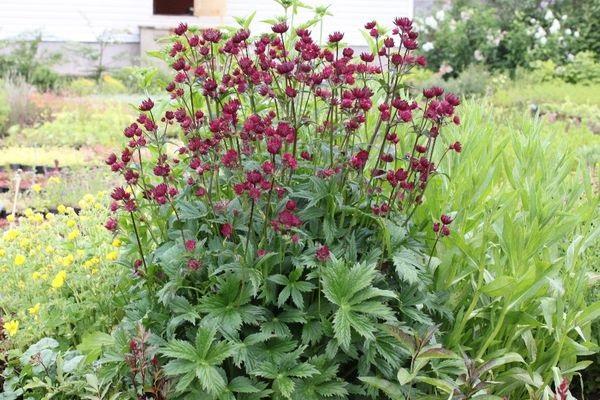

Watering
Water the bushes with heated water after sunset. You can water early in the morning when the sun's rays are not yet so aggressive. In the spring after planting, watered 3-4 times a week. In summer, every day, especially if the heat is long. If it rains often, then you need to be guided by the conditions of the plants. If they are green and bloom profusely, you do not need to water extra.
To reduce the amount of irrigation, you can mulch the soil in the flower bed. The mulch layer should not be less than 15 cm. In addition to retaining moisture in the soil, this layer prevents weeds and protects the root system from frost in winter.
Loosening and weeding
Once a week, before watering, the soil is loosened and weeds are removed. It is better not to allow the appearance of weeds at all, to pull them out immediately. The soil is weeded to a depth of 5-7 cm.
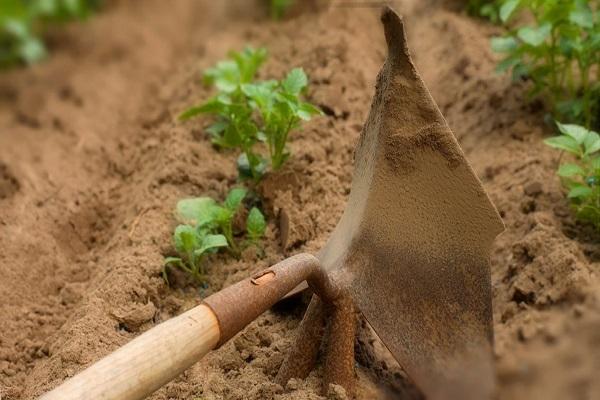

Pruning
Cutting is necessary for faded inflorescences. You need to cut them off right away so that the bush does not look "naked". Dry leaves and stems are also regularly removed. Closer to autumn, when the flowering period is over, the stems are cut so that at least 15 cm remains from the ground.
Top dressing
Astrantia is one of the few plants that you don't need to fertilize. Without top dressing, the bush can grow and bloom quite successfully.As a preventive measure, several times a month, the flower bed can be watered with complex mineral fertilizers or manure diluted in water.
Transfer
Transplanting the crop is often unnecessary. The transplant can be carried out every 3-4 years.
Diseases and pests
Astrantia rarely gets sick and is practically not attacked by insects. For prevention, you need to regularly destroy weeds from the flower bed. In principle, this measure will be enough for the bush to be healthy all the time and bloom profusely.


Main characteristics
Astrantia is an abundantly flowering perennial that is distinguished by its spectacular appearance and ease of care.
The height of the plant, depending on the variety, can vary from 15 to 90 cm. The foliage of Astrantia is mainly palmate, but there are varieties with separate and lobed ones. The plant has a straight rhizome, long flowering, its shoots are weakly branching. Astrantia bush is a little leafy, but spreading. The rhizome is quite powerful, but compact, the flowers are collected in numerous small inflorescences, which outwardly resemble umbrellas. The petals of flowers are most often of a pale pink hue, but, depending on the variety, are still white, purple or red.
The main advantage of Astrantia is the long flowering period, which lasts from June until the first frost. Abundant flowering, for which the flower is appreciated by many growers. The fruit of the plant is represented by a two-seed. Astrantia flower has an interesting texture, therefore it can serve as a material for textured compositions.
It can serve as a material for textured compositions.
Variety selection
For a long time, the culture was not in demand, but over the past decades, breeders have developed new varieties and hybrids that differ both in the height of the peduncles and in the shape and color of the inflorescences.
There are miniature varieties, the height of which does not exceed 15-20 cm, and there are those that reach 90 cm. The ground diameter of the bush also differs. Hybrids have been created with an incredible flowering period that exceeds natural indicators by two times. Such representatives of the starfish begin to open the buds in mid-May and do not complete their formation until the autumn cold snap.


Varieties that are often used in horticulture:
- Sunningdale Variegata... It is characterized by a creamy color of foliage with beige streaks and an original color of inflorescences, which, as they unfold, change color from greenish to pink. On the bush, many flowers can be present at the same time in different degrees of disclosure, which makes the plant two-colored.
- Florence. The height of the peduncles varies from 40 to 60 cm. It has bright pink flowers and deeply dissected leaf plates, which retain their decorative effect throughout the growing season. Florence is considered the leader among all varieties in terms of flowering duration.
- Superstar... A distinctive feature is a silvery-green receptacle surrounding a wreath of rose petals. About 40 inflorescences can bloom at the same time, which makes the variety one of the most lush.
- Star of Beauty... It has very dark burgundy or dark cherry petals, which is not typical for this culture. Bracts protrude far beyond the petals, and due to this, the inflorescence looks double. The original shape makes the variety an excellent component of winter bouquets, which does not lose its attractiveness after drying.
- Moulin rouge... One of the most frost-resistant varieties, therefore it is recommended for planting in regions with harsh winters.
Characteristics of species and varieties
The Astrantia family has about 40 species. In modern gardens and parks, flowers of two varieties are most often found: this is a large and large Astrantia. These two varieties are very similar in their characteristics.
Astrantia is large in height, reaching 80 cm. Its flowers are pale pastel colors, they begin to bloom in the middle of summer and continue to bloom for one and a half months.The peculiarity of this plant is that it does not require any maintenance at all. In turn, this variety is subdivided into the following varieties:
- Lars - flowers are distinguished by bright pink inflorescences, which reach 75 cm in height.
- Moulin Rouge - flowers of purple-pink color, which over time acquire a lilac-purple hue. The variety is considered very hardy. Astrantia of the Moulin Rouge variety reaches a height of 60 cm.
- Rosensimphonie - flowers are very large and beautiful, bright pink.
- Sunningglade Variagated - flowers of this variety reach 70 cm in height and are pale pink in color.
As for the large Astrantia, this plant is often found in the Caucasus. It begins to bloom in June. The flowers are small, pale pink, with a pleasant aroma. The main advantage of large Astrantia is that the plant has decorative large leaves, collected in a powerful rosette.
One of the most common products of Dutch breeders is the wine-red petaled variety called Claret. Plants of the Astranian variety Claret reach a height of 50 cm and are distinguished by abundant flowering and palm-shaped leaves. Bloom from June to September.
Another widespread variety is the large pink astrantia. This original plant is distinguished by large flowers, bright pink hue, which reach a height of about 80 cm and look great near water bodies and in mixborders. This variety blooms from July to October and is classified as a hardy plant.
Astrantia big pink
General characteristics
The Astrantia genus is distributed in all parts of Europe, Asia and the Caucasus. In natural conditions, three main varieties can most often be found:
- Large (large). As the name suggests, this variety includes tall plants reaching 70 cm in height. Inflorescences are most often devoid of bright colors, but continue flowering for a very long time. Bud formation persists throughout the summer months and ends in August-September.
- The greatest. It is found mainly in the Caucasus. Its stem is shorter, but the inflorescences are much larger and brighter. It is an excellent honey plant, so it is often used to create a butterfly garden. Flowering covers the last summer months and the first half of autumn.
- Small. The name was obtained not for the height, but for the size of the flowers, which is only 3 cm. The foliage is also thinner than that of other varieties, but looks more decorative because of the jagged edges.
The flower is characterized by high resistance to negative weather factors. Due to its powerful and deep-lying rhizome, it is drought-resistant and frost-resistant. The leaves are located at the base of the bush, and the peduncles rise upward, forming a dense ball of bright inflorescences.
After planting, the curtains actively grow, forming a continuous carpet in 3-4 years. At the same time, the overgrowth does not affect the flowering intensity, therefore, having once planted a starlet on the site, they enjoy it for 10-12 years without transplanting or thinning.
Astrantia is used for planting in the central part of the lawn, for curbs and foothills of alpine slides, as components of a mixborder, etc. The inflorescences stand well in live bouquets, and after drying, they form persistent winter compositions.
Planting and leaving
All Astrantia are unpretentious plants that are unique, unpretentious and plastic. They can be grown on almost any soil, regardless of whether the crop is in the sun or in the shade. The only thing to consider is that it is not recommended to plant the plant in purely sandy soil, as well as in those places where the culture will be in direct sunlight all day.
The plant is resistant to pests and diseases, and also tolerates cold well.Another feature is that flowers can grow in one place for more than 12 years without losing their decorative effect. However, experienced flower growers recommend planting bushes every 6-7 years. The plant grows rapidly, within a few years after planting dense clumps are formed.
Reproduction of Astrantia most often occurs by seeds. At the same time, experts do not recommend giving preference to self-sowing, since such seedlings rarely retain varietal characteristics. The best option is to collect seeds or purchase and sow them.
Note! For planting, it is best to purchase planting material only in specialized stores.
Sowing of the collected seeds can be carried out in the fall. In this case, in the spring, after the emergence of seedlings, it will be enough to simply thin them out.
You can also grow a plant through seedlings. For this, the sowing of seeds occurs in early spring in boxes. It is best to sow seeds in nutritious light soil, which, after planting the seeds, is covered with film or glass and kept in a warm place in which the temperature is maintained between 20 and 24 degrees. After the emergence of seedlings, it is not required to cover the plants; the boxes must be moved to a well-lit place. As soon as several weeks have passed from the moment of germination, it is imperative to thin out the seedlings. Plants are split into individual pots as soon as the first pair of true leaf plates appear.
Plants are transplanted into open ground after they have fully adapted to new conditions. This mainly occurs in the last days of May or early June. There is nothing complicated in the process of planting these plants. The only thing that needs to be taken into account is that after planting, the crop should be at the same level as it grew in the pot. Also, between the bushes, a distance of at least 0.3 m must be maintained. When growing astrantia through seedlings, flowering begins after three years.
Astrantia can also be propagated by cuttings or cuttings, which are planted in wells prepared in advance in the flower garden.
Astrantia flowers do not require specific and careful care. If there is no abnormal heat in the summer, then the culture does not need any care at all. During drought or heat, the main condition for comfortable growth is systematic watering, after which it is recommended to loosen the surface of the site.
In order for the plant to become lush and symmetrical, you need to cut off all the inflorescences after the bush has faded for the first time. It will also help stimulate the growth of new flower arrows. It is recommended to feed the plants only once, in the spring, at the moment when the culture begins to grow. For feeding, it is better to use a complex mineral fertilizer in liquid form. If you plan to use dry fertilizer, then you must immediately water the plants.
Note! The culture does not require special preparation for winter. Experienced growers advise cutting off the ground part of young plants, as well as covering them with mulch. As for adult bushes, they winter well and without shelter.
Seed collection and wintering in astrania


Astrantia large photo
If you are interested in collecting seeds of Astrantia, then at the end of flowering, do not cut off the largest inflorescences from the bushes you like, but put them in gauze bags so that the ripe seeds do not fall out on the ground. Once completely dry, cut and place in a dry, well-ventilated area. When the seeds are dry, you need to peel them out of the husks, put them in a paper bag for storage.
Self-seeding of starfish is undesirable, therefore, we remove wilted inflorescences from the flower bed
It is recommended to cut off a beautiful bouquet and dry it, as astrantia stays dry for a very long time and will decorate your home in winter.
The starfish does not require special preparation for winter.For young bushes, it is advisable to cut off the ground part and cover with mulch. Adult bushes winter well and without shelter, although hardworking flower growers also shelter adult plants for insurance.
Astrantia grows comfortably in one place for up to 10 years, but it is better to plant it every 7 years, so it looks fresher and more luxuriant.
Growing problems and pests
These flowering perennials, according to the descriptions, are practically not susceptible to diseases, and they are also not attacked by any pests. But, despite this, if you take care of the culture incorrectly, then its immunity can be significantly weakened.
Slugs can only eat their foliage. You can get rid of pests with the help of a drug like Thunder, or using the old method: sprinkle the plants with wood ash. After winter, it is imperative to pay close attention to young leaves, since these pests mainly appear during this period of time. To prevent fungal diseases from appearing, prolonged overflow should not be allowed.
Pest control
Since Astrantia is a very hardy and pest-resistant plant, it needs almost no protection. Ornamental plant varieties can only suffer from the action of naked slugs, who decided to feast on its leaves. After their invasion, the starfish loses its attractiveness, so it is advisable to take preventive measures.
The flower beds on which the flower grows are treated with slug-destroying agents. The drug is scattered near plants in need of protection and left - upon contact with it, the pest quickly dies, not having time to reach the bush.
Instead of chemicals, you can use a safer method - manually killing slugs.
Reproduction Astrantia: planting seeds and cuttings
In order to get astrantia on your site in the garden or front garden, you can act in several ways of reproduction and planting of this plant. The fact is that although it is not difficult to grow this perennial, it can take some time. In total, there are three ways of propagation of astrantia: cuttings, division of rhizomes and seeds. Let's try to talk about them in turn.
Garden crops in Astrania are not picky plants, so any garden soil is suitable for them. But, some gardeners, in order for the flowering to be much longer and brighter, fill the soil before planting a perennial. For this, ordinary humus is used. If this is not done, then a transplant may be required in 5-7 years to another place. In order for Astrantia to live on one site for 10-12 years, loose and fertile soil is needed.
Vegetative propagation of Astrantia is possible by cuttings or by dividing the rhizome. In both cases, this happens in the fall or spring. In the case of dividing the rhizome, a plant without leaves is taken, that is, you need to wait for the moment when they fall off or take a copy with leaves that have not yet awakened. The perennial astrantia is dug out of the ground, after which its root is divided into several parts. Then, you need to plant it in different areas. To propagate astrantia with petioles, you need to divide the root rosette, after which they are also seated in prepared places. When using vegetative propagation, Astrantia blooms for 2 years of life.
Benefits of astrania as a perennial
In addition to its original appearance, this rare flower has many other positive aspects that contribute to the plant becoming more widespread.
The flowering time of Astrantia is from June to August, and in some varieties, a second wave of flowering is observed in September. This is not only a worthy decoration of flower beds, but also a godsend for florists, because Astrantia is cut for a long time (up to two weeks fresh) and forms original combinations with other flowers.
Astrantia is also good as a dried flower, since it, like all umbellates, perfectly retains its shape. Cutting the inflorescences of Astrantia contributes to its longer flowering.
Astrantia is a good honey plant and with its wonderful honey aroma and the appearance of inflorescences attracts many insects to the garden. Thanks to astrantia, colorful butterflies will always be present in your garden, because it is very difficult for winged beauties to resist the attractive power of this flower.
This perennial is a hassle-free plant that is suitable for busy gardeners, if you initially choose the optimal planting site for it. Astrania's only requirement is regular watering in drought conditions. But pests and diseases usually bypass this flower.
Astrantia will grow in one place for a long time without transplanting and will delight with its regular flowering. Over time, the bushes will grow in breadth, but the plant is not aggressive, retains a compact shape and does not interfere with the neighbors in the flower garden. This perennial is quite tall, but its dense stems do not require a garter.
Astrantia winters well without any shelter. And it will develop well and endure winters in regions belonging to the 4-9 zone. That is, this perennial is absolutely resistant to the climatic conditions of the middle zone.
A romantic-looking plant, this flower is ideal for nature-style gardens, mixborders and shady flower beds. But, in principle, Astrantia is universal and you can find a place for it in any garden.
Dark-colored varieties of intricate "jagged" flowers will add a bit of mysticism to the garden, while pink stars, on the contrary, will add a romantic mood. The most spectacular will be the massive landings of Astrantia.


Dark-colored varieties of intricate "jagged" flowers give the garden a bit of mysticism. <людмила>
Appearance
Astrantia is a representative of the Umbrella family. A perennial herb with a well-developed powerful root system.
Stem smooth grassy, reaches a height of 15 to 90 cm.
Leaves carved, leathery, dense, green and dark green.
Flowers umbrella, of various colors. In the middle there are many small flowers, united by a single wrapper of thin petals. The color of the wrapper often differs from the shade of the inflorescence, which gives it a certain expressiveness and splendor. When the faded flowers are removed, the plant tends to renew itself and expels new buds. The flowering period is from July to September. Ripe inflorescences have fruits - two-seed.
The photo shows a general view of the flower, which, by the way, is an excellent honey plant.
The plant easily tolerates drought and frost, does not require special care.
In European countries, the plant is widely used in the creation of decorative flower zones and garden designs. It is prized for its decorative appearance, and many hybrid varieties were bred for a variety of paintings. In fact, there are a little more than 10 types of Astrania, but this does not interfere with its popularity.
Healing properties
Astrantia large is characterized by a straight, well-developed branched stem. Large juicy leaves are concentrated at the root collar of the trunk. In medicine, the root and the ground part of the culture are used.
In the summer, the ground part of the plant is cut off. The harvesting of the root part of the plant is carried out in early spring or autumn. The material is dried in the fresh air under the roof. The stems can be tied in bunches and hung in a ventilated area, and the roots can be laid out on a wire rack. After drying, the workpiece is placed in fabric bags and stored in a dry place. It is usable throughout the year. The ground part of the plant is rich in acids:
- tsavel;
- oxycarboxylic (apple);
- lemon.
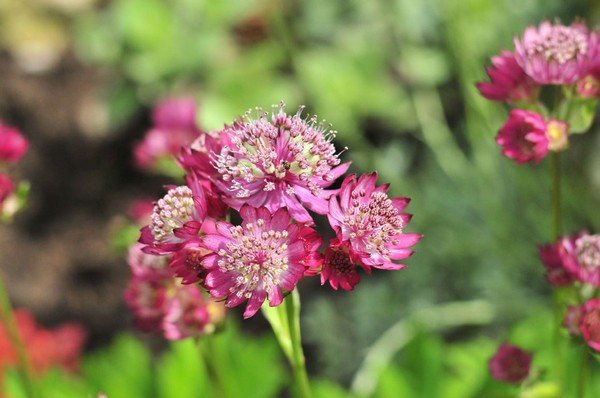

Although the effectiveness of Astrantia and its positive effect on the human body have not been proven until the end, it is actively used in traditional medicine.
Leaves, stems and flowers contain flavonoids (ground part).
| Substance | Description |
| Rutin | Improves blood circulation, helps prevent thrombosis. Rutin is a representative of antioxidants and provides protection against ultraviolet radiation. |
| Quercetin | The strongest antioxidant, has antimicrobial properties that suppress the process of inflammation in the body. It is necessary as a supplement for patients suffering from hypertension. |
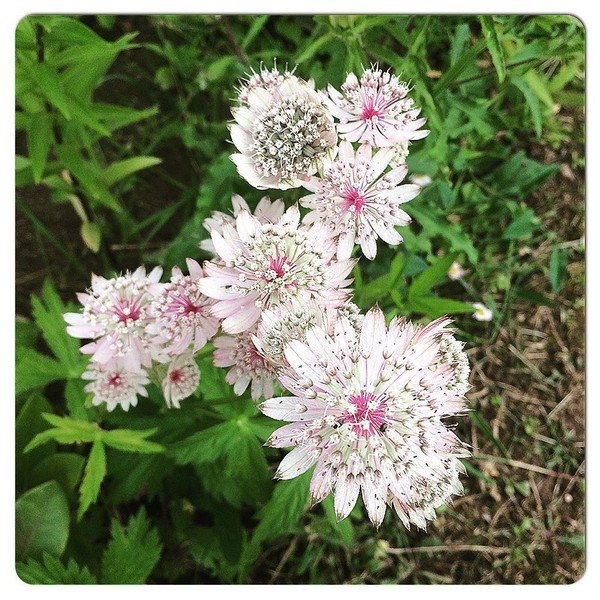

The leaves, stems and flowers of the plant contain flavonoids
The use of the plant part as a medicinal product contributes to the regulation of metabolism in the body. This fact is explained by the presence of steroids. The roots contain vegetable glycosides (saponins). They have a beneficial effect on the body in case of colds (bronchial inflammation), promote the excretion of phlegm. However, there are side effects in the form of allergic reactions or urticaria. This medicine can cause nausea, vomiting, and diarrhea.
Important! It is necessary to take into account, when ingested, contraindications and toxicity of the substance.
Take a medicinal product in the form of decoctions. A dry grated plant is brewed in boiling water, in a proportion of 2 teaspoons per one glass of boiling water. The herbal composition is brewed for 5 minutes, and the root - 20 minutes. Then you need to strain the broth and take three times a day, one glass at a time, warm.
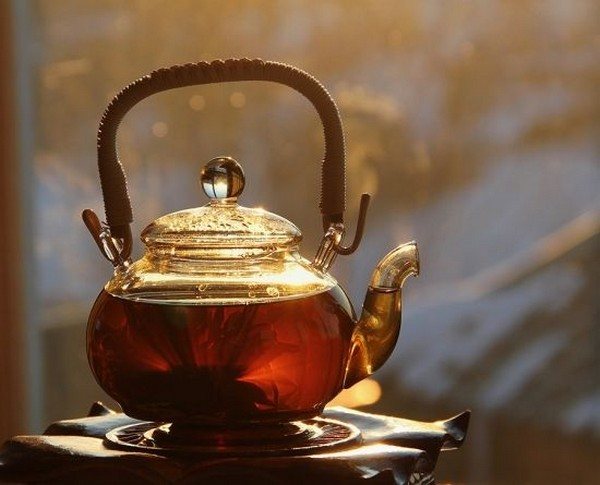

Most often, Astrantia is taken in the form of decoctions.
Important! The properties and side effects of Astrantia large have not been thoroughly studied, therefore, medicinal decoctions must be taken strictly on the recommendation of the attending physician. It is unacceptable to take drugs by yourself. The medicine in the form of a decoction is prohibited for pregnant women, lactating women, as well as children.
Description of the species
The genus Astrantia is represented by 11 species, one of which is called Astrantia large. The first three years the plant develops, is characterized by lush bright green leaves, but does not bloom. In the fourth year, the first inflorescences appear. The stem of the developed culture reaches one meter (maximum) in height. In the upper part, the stem of the four-year-old culture is divided into several processes. A "bouquet" of inflorescences is formed on them. A small flower is formed on each divided stem, up to 5 centimeters in diameter. The main axis of the inflorescence is shorter than the others. Pedicels with additional small inflorescences, which are located at the same level, emerge from its top. The perianth is represented by oblong petals.
The color scheme of the petals that form the bracts on the inside may vary depending on the variety. Astrantia leaves are large, dissected, bright green in color. They consist of five large carved plates connected at the base of the stem. The root of a four-year-old culture is fibrous.
Important! When a plant propagates, it can be divided.
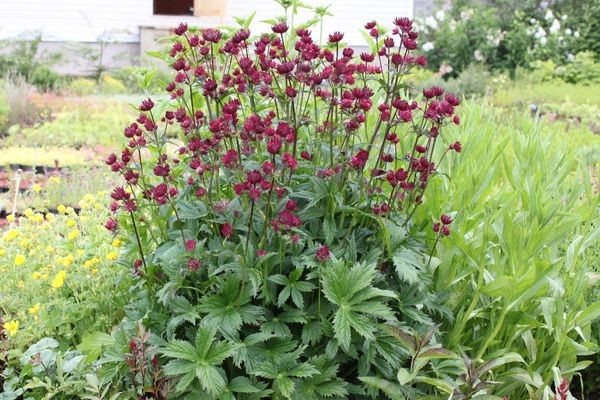

This plant does not begin to bloom immediately - as a rule, this occurs only in the fourth year of life.
A small shoot of the root can give life to a new plant. The culture blooms from the second half of summer until autumn.Provided that the inflorescences are cut, it blooms twice a year.
Breeders have bred by crossing many frost-resistant varieties that delight gardeners with the beauty and tenderness. Let's list some.
- Alba is a monochromatic, light green inflorescence of a perennial culture.
- Claret - bright ruby, monochromatic flowers.
- Gill Richardson - monochromatic dark red inflorescence.
- Pink Joyce - in the second half of summer, the flowering period begins. The flowers are solid, bright, pale pink.
- Penny`s Pink - the flowers are white-pink, pale, the perianth petals are penetrated with brighter veins.


Astrantia variety Penny`s Pink is distinguished by white and pink flowers - Roma - petals of a pale pink shade around the edges with bright pink edging, the flowers of the inflorescence are deep pink.
- Purple Joyce - bases of purple inflorescences of a green tint, perianth leaves with a purple tint.
- Red Joyce is a short plant, up to 50 centimeters, with bright red uniform inflorescences.
- Ruby Cloud is a tall culture, up to one meter, with contrasting shades of bright ruby flowers and light red perianth petals.


Ruby Cloud Variety - Star of Beauty is a low-growing variety, flowers are light with red edging, petals are pale red.
- Sparkling Stars Pink - undersized crop, flowering until August, monochromatic pale red inflorescences.
- Star of Billion is a variety of contrasting delicate shades, the petals are light green, and the flower itself is white.
- Venice is a species with bright red flowers and purple petals, the stem height reaches 60 centimeters.
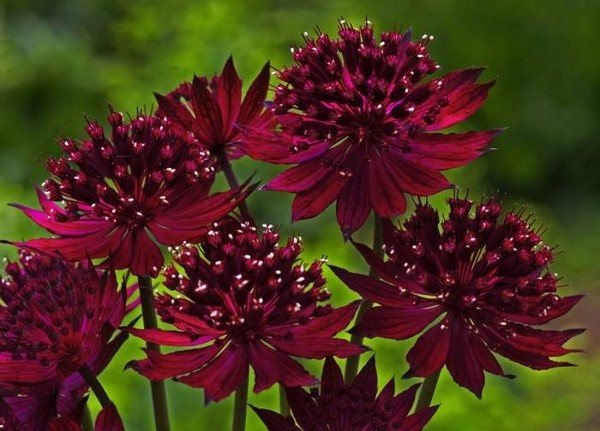

Astrantia Venice is distinguished by its bright red flowers
Agrotechnics
Growing from seeds
Strelitzia flower: examples of care and growing at home
Growing Astrantia from seeds at home requires special attention and control. This culture reproduces well by self-seeding, but at the same time it does not retain all its characteristics. The nurturing process is easy, but some guidance is needed.
Seeds can be sown:
- In the fall, when the flowers are harvested, in the spring they sprout themselves. This method can only be used with self-collected seeds.
- Store seed is sown only in the spring.
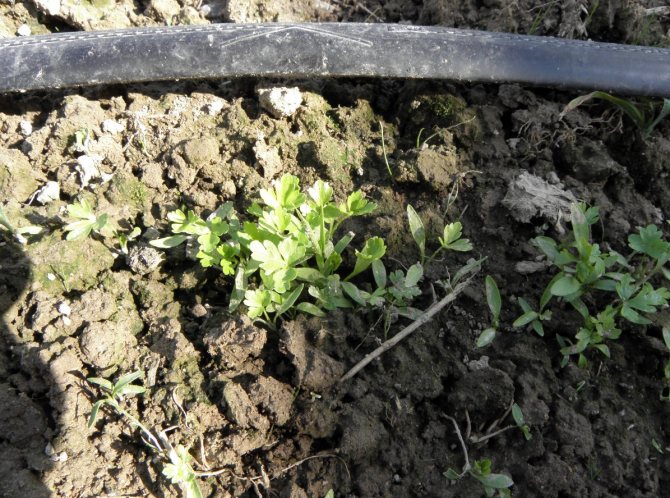

What seedlings look like
Recommendations after purchasing seeds in the store:
- Seeds need to be stratified, that is, cooled. It is enough to put them in the refrigerator for several weeks.
- Planting for seedlings is carried out in early spring, in March. A seed is sown shallowly into loose soil and they try to withstand it at a temperature of 20-23 degrees. The top is covered with a film, but the moisture is retained during watering. After a few weeks, seedlings appear, so the film can be removed, and the seedlings themselves can be thinned.
Additional Information. The aging process at low temperatures naturally takes place when sowing in the fall, but under natural conditions. Sometimes, the packaging of store seeds may indicate that the seeds are already stratified.
What is needed for landing
When planting and caring for an Astrantia flower, it is important to adhere to the main rule - light soil, rich in oxygen.
For landing you need:
- Prepared stratified seeds,
- Loose light soil,
- The room temperature after planting is not lower than 20-23 degrees before the start of germination and the appearance of seedlings.
An important factor in the rapid development of shoots is the presence of sunlight.
Growing seedlings
Seedlings begin to grow quickly if all the rules are followed. After two weeks, the seedlings can already be thinned out. While the seedlings are actively growing, they need to be constantly watered, and the soil must be loosened. In no case should drafts be allowed.
If small leaves appear on the seedlings, you can dive the plant and plant it in small pots with the same soil in which the seed was planted.
Note! Before planting a culture in the garden, it is worth starting to temper it. The process is very simple: take the pot outside for a few minutes to “walk”.Gradually lengthen the time spent in the fresh air.
Step-by-step process of planting in the garden
Planting astrantia planting and leaving in the open field will not cause any particular problems even for a beginner. The culture is very close to the field species.
Planting is carried out in late May or early May, when the seedlings are already actively developed. By the time of frost, the culture will have a stronger rhizome and will be able to withstand the frost. Already formed strong seedlings are planted. They will give the first flowers only after 2-3 years.
Scheme:
- The soil is being prepared. It should be light, loose, without loam and stagnation. It is possible to add black soil if the soil is acidic or too alkaline.
- Small pits are dug, where a drainage layer of sand and organic fertilizers (for example, household waste, plant tops) is introduced.
- Wells are watered abundantly with water and rhizomes are planted.
- The soil is compacted tightly and is watered again.
- Additionally, the soil can be mulched with hay or straw.
Care
Astrantia requires constant but uncomplicated care.
Watering mode
Watering should be regular and of good quality. In hot summer time - once or twice a week, in autumn - once every 10-15 days. Rain or settled water is used. As a supplement, it is allowed to water the plant with decoctions of chamomile, sage, nettle, dandelion or egg shell infusion. Eggshells also help in the fight against bears.
Top dressing
Top dressing is allowed, but you can not overdo it. The culture grows well even without fertilization.
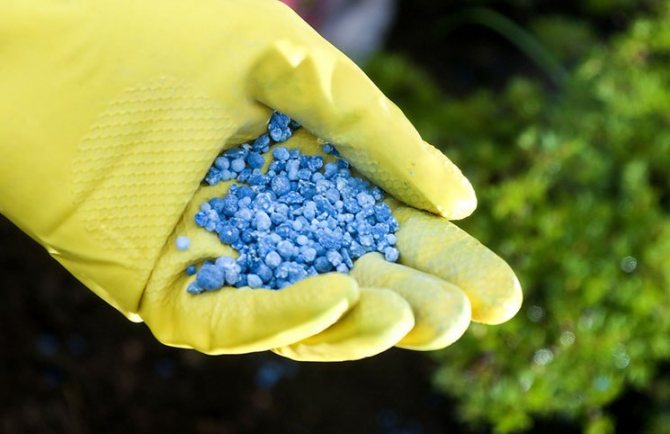

Phosphate-potassium fertilizing
Before the onset of bud growth, nitrogen fertilization is introduced, after flowering - phosphorus-potassium. Follow the instructions strictly.
If Astrantia blooms on soil poor in minerals, then it is allowed to introduce additional fertilizing of phosphorus and potassium in the middle of summer. Liquid fertilizers are very good for crops. When applying dry dressing, it is imperative to make abundant watering after applying it.
Flowering care
The gardener needs to ensure that the soil does not dry out in Astrantia. With prolonged drought, the plant will also develop, but flowering will suffer. Most likely, under such conditions, if it blooms, then only once. Therefore, if you want to re-flowering, you should water the culture abundantly.
It is also important to constantly loosen the soil and remove all weeds that interfere with flowering and crop development. Mulching with peat or humus helps to control weeds.
If faded inflorescences appear, they must be removed immediately. After the first flowering, it is better to cut off all the flowers so that the second ones can be re-set. This procedure will help the shrub look fresh and well-groomed.
Resting care
When the flowers of Astrantia have finished blooming, they should be cut almost at ground level. This will make it easier for the plant to survive the winter. You can also make a top dressing to fill the culture with the necessary minerals. Watering becomes less frequent - up to once every 10 days.
Additional Information. In the fall, they begin to collect seeds. For this, gauze bags are taken, they cover those flowers where the seed does not spill out on the ground. After the inflorescences have dried, they are cut off and dried in a dry, well-ventilated room. The seeds are then shaken out and placed in paper bags for further storage.
Preparing for winter
In general, Astrantia tolerates frost easily. But, if these are young shoots, it is better to additionally protect them by mulching with sawdust or dry foliage.
There are a lot of varieties of incredible beauty of the plant. At the same time, choosing your favorite will not be difficult. The star flower will subsequently delight everyone with its flowering and will become the highlight of any flower bed.
Content
- Listen to the article
- Description
- Growing astrantia from seeds Sowing
- Seedling care
- Astrantia dive
- When to plant
- How to grow
- How and when to collect seeds
Preparing for the winter period
In the second half of summer (closer to autumn), it is recommended to apply potash - phosphorus fertilizers. They allow the culture to better prepare for winter, to ripen shoots that will bloom next year. Watering should be stopped. In the fall, the plant is pruned. The culture is frost-resistant, but in the case of growing in regions with harsh conditions, the root system is covered with a ten centimeter layer of peat or compost soil. The bush in November (the plant should not rot) is covered with spruce branches (branches of conifers).
Important! Do not cover with cellophane film, the culture may rot and die.


It is important to prepare the plant for winter
History of origin
Like any other flower, Astrantia has its own fabulous origin story. Legend has it that once a star fell from the firmament and shattered into tiny pieces, which turned into beautiful flowers at sunrise. The story is more like a fiction, but, if not for one similarity, the shape of the flower really resembles an asterisk.
The people call this unusual flower - a star or a star. It grows in the territories of Asia, Europe, America, Great Britain and the Caucasus, in addition, in European countries, the plant is very popular and is cultivated by many gardeners, creating many-sided landscapes.
Description of the plant
Astrantia shoots are straight, have a small number of leaves and branches. The plant grows in length from 0.17 to 0.85 meters. Small leaves are obovate. They are collected in nodules that are located closer to the root.
Umbrella-shaped inflorescences, resembling stars, consist of small pink or white flowers. Blooming Astrantia begins in late spring and lasts until early September.
The culture is a honey plant, as it attracts insects to itself. It can withstand frost and heat. Astrantia is planted in flower beds, group plantings are arranged with it, and used to decorate paths or decorative elements.
This culture is combined with astilba, lungwort, hosts, geraniums, heuchera. Astrantia is also great for creating long-lasting dry bouquets.
Leaving after disembarkation
Annual dahlias - planting and care
After planting in open ground, you need to regularly care for the plants. The main care is reduced to the following activities:
- Regular and high-quality watering (in the hot period - 1-2 times a week, in the autumn period - 1 time in 10-15 days). For irrigation, it is necessary to use settled or rainwater. Additionally, you can water the bushes with decoctions from plants: chamomile, sage, nettle, dandelion, eggshell infusion.
- Weeding and weeding.
- Loosening the soil to enrich it with oxygen and improve the supply of fertilizers to the root flower system.
- Timely removal of faded peduncles, dried leaves, broken stems and flowers to stimulate the formation of new peduncles and enlargement of flowers. Correct pruning promotes the formation of new and larger flower stalks.
- Fertilization (phosphorus-potassium, nitrogen). Fertilizers are applied before budding.
- Carrying out preventive measures in the fight against pests and fungal diseases. Treatment of bushes with a solution of copper sulfate, fungicidal preparations.
- For the winter period, the shoots are completely cut off from the plant, from above it is mulched. In the spring, the mulch layer is removed and shoots appear.
- Installation of trellises (supports). In case of intensive growth, it is recommended that plants be tied to stable supports to ensure stability in rainy and windy weather. Also, thanks to the supports, the flower “fence” will be taller, thicker and more attractive.
- Transplant after 5-7 years of growth in one place.Growing astrantia in one place for more than 8 years negatively affects growth, appearance and flowering. Peduncles become much smaller, the stems are elongated, the leaves turn pale and lose their attractiveness. Also, a transplant is recommended when the bush is decorative. In this case, the bush is cut and planted in a new place.
Note! High-quality and competent care will ensure intensive growth, abundant and long-lasting flowering.
Reproduction
Astrantia reproduces in two ways - by seed and by dividing the rhizome.
Seeds
Seed propagation is carried out in spring or autumn. In the first case, the planting material is planted for seedlings in the spring at home. When the seedlings grow up and it becomes warm outside, they are planted in open ground.
Dividing the bush
The second way is by dividing the bush. This method is suitable if the bush has already grown a lot and needs to be replanted. Instead of transplanting, you can cut the plant into several parts and plant it. Reproduction is carried out in this way in the fall. In the spring, new bushes will begin to actively grow.
The advantage of this propagation method is that you do not have to deal with growing seedlings, and the bushes will begin to bloom faster after transplanting to a new place.
After flowering
After the inflorescences have faded, you need to start preparing the plants for winter. Unlike many flower cultures, Astrania is unpretentious even in this.
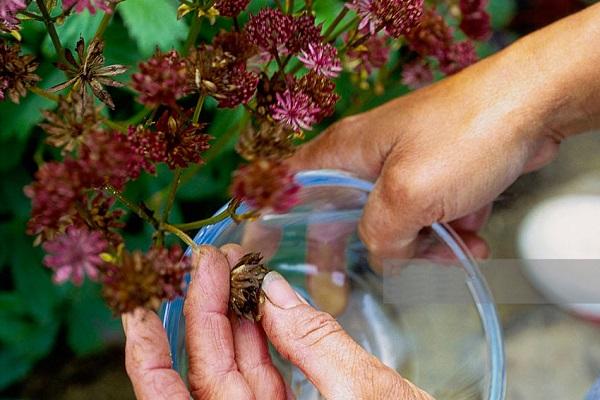

Collection and storage of seeds
The seeds can be harvested throughout the summer as soon as the flowers have faded. Faded flowers are cut and laid out in a dark room so that they dry completely. After that, it is easy to collect the seeds. The collected planting material is stored in the refrigerator for no more than two years.
Preparing for winter
Astrantia belongs to frost-resistant plants, so it is not necessary to cover the bushes for the winter.
Astrantia: the origin of the species
Astrantia is widespread in America, England and Eastern Europe. This species is adapted to the conditions of the middle lane. Belongs to the umbrella family, the leaves are poorly developed, the plant can reach a height of 1 meter.
Astrantia was first cultivated in England in the 16th century due to its ability to attract bees and its simplicity. The species came to Russia from Great Britain. The plant can grow in open plains, in partial shade and in completely shaded areas, but the flower stalks will be small and less bright.
After cutting, the flower is able to stay in the vase for a long time without losing its appearance. Dry compositions are created from it.
Disembarkation and reproduction
Florists plant seeds in prepared containers filled with fertile soil. The container for planting is pre-disinfected with a solution of potassium permanganate. Seeds are dicotyledonous cone-shaped, the shape looks like a sunflower seed.
Planting begins at the end of March. The sprout appears within five weeks, develops quickly. After the appearance of the second and third leaves, it is necessary to dive the seedlings. In a cramped and shallow container, seedlings grow poorly, the sprouts stretch out, the stems become thinner. Lack of nutrition and light negatively affects the vegetative properties and quality of seedlings. She becomes brittle, pale and withers.
During the period of freezing temperatures, containers with seedlings can be taken out into the open air (garden plot, balcony) to harden the plant.
Important! You should not leave tender sprouts in the direct spring rays of the sun. Delicate sprouts can burn and die.
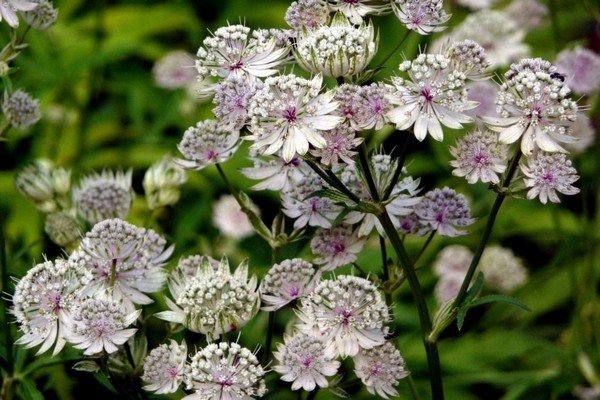

Usually such a plant is planted at the end of March.
Hardened seedlings take root well in the open field. Landing is carried out in the spring (when the ground warms up well) or in the fall. Seeds of a certain variety are purchased in the store or harvested on their own after flowering. In this case, the culture may not repeat the varietal characteristics.
You can propagate a flower by dividing the root system of a perennial plant.The ground part is cut off with a secateurs. A carefully dug root is divided into the required number of shoots, transplanted into a prepared planting pit. After planting, the soil is moistened. Even a small root outgrowth or part of the system is capable of producing full-fledged shoots.
Important! The place for planting is determined depending on the aesthetic feasibility and the availability of free space in the flowerbed or in the garden. The plant is unpretentious, develops in the shade and in open sunny areas.
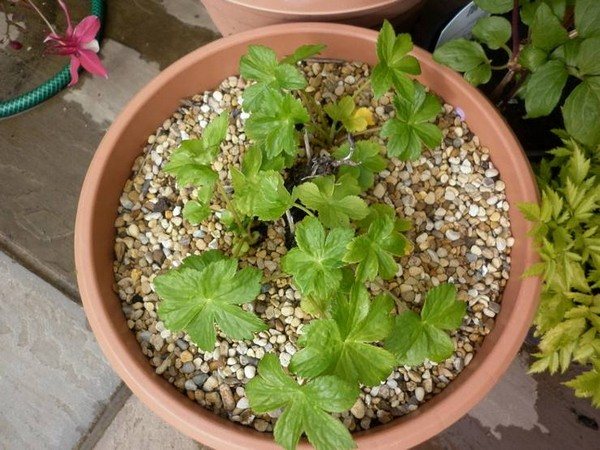

Astrantia can be propagated by seeds and root division
Waterlogging of the soil affects the development, the culture may die. In sunny areas, the plant develops better, the inflorescences are brighter, larger, and the colors are more juicy. In the shade, the flowers are painted in paler colors. During the budding period, watering is required at least once a week. If the florist wants to get large flowers for cutting (bouquets), the number of flowering processes should be reduced to three or four pieces per bush. In an annual flower, the root is not yet developed and cannot be divided.
The flower gets along well in one place for about seven years. It harmonizes in cohabitation with other flowers, forms a bouquet, saturates with bright shades. The soil can be different - from loam to sandy. The plant develops better in loose and fertile soil. If the site has clay or stony soil, it is necessary to dig a planting hole larger than the root system, fill it with fertile soil. When determining the size of the planting pit, take into account the place for further root development.
Important! In an "artificial container" or trench, the culture is able to develop and bloom.


Astrantia loves sunny places more
You can also propagate the culture by cuttings. Branches (cuttings) are placed in water or in fertile soil (substrate) with a rooting agent. After the roots appear, they are transplanted into open ground. It is possible to root the cutting by tilting the branch to the ground and sprinkling it with damp earth. One season is enough for rooting. The stalk with pruning shears is cut from the "mother branch" and transplanted into a prepared planting pit.
Views
Astrantia varieties are divided into several types depending on the height of the bush.
Large
In these varieties, the main stem can grow up to 1 m.The bushes are large and spreading.
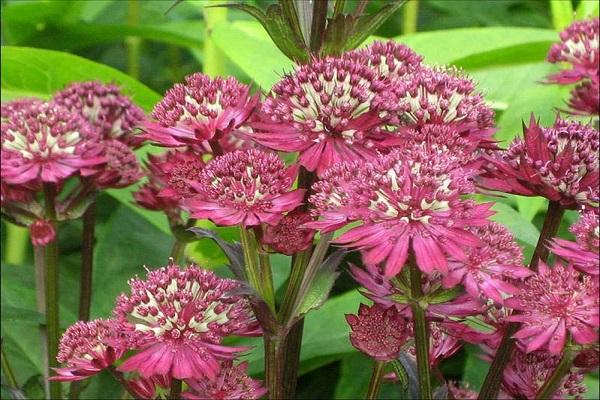

The greatest
The bushes are large, grow to a height of 70-85 cm. This species grows in the Caucasus. The inflorescence is large, about 7 cm in diameter. The flowers are pink.
Small
Plants are small in size, up to 60 cm high. Branching is average. Blooms later than everyone else, in August-September. Dusty pink inflorescences.
Karniolskaya
The height of this variety of bushes is 40-55 cm. The plant is not branched, slightly leafy. Fuchsia-colored inflorescences.
Interesting: Krinum is an unpretentious beauty
Reproduction of Astrantia
For this plant, vegetative and generative reproduction methods are used. At the same time, seed reproduction does not guarantee that all varietal characteristics of the species are preserved. Only the vegetative method of reproduction allows the maximum preservation of the varietal characteristics of the mother plant.
For its implementation, the rhizome of the plant is divided into small segments, which are then planted in separate holes. The division is carried out in the spring, before the shoots appear. With this method of reproduction, in the first two years, Astrantia increases the green mass, and only in the third year does it begin to bloom. The advantage of this method is the ability to get a large number of plants from one mother bush, since even a small part of the rhizome quickly sprouts.
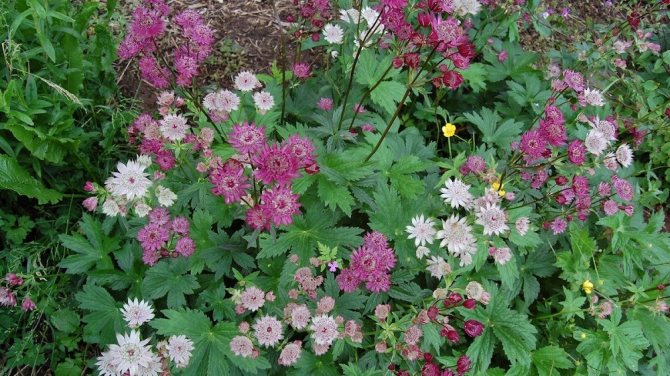

Astrantia can be propagated by dividing the rhizome

